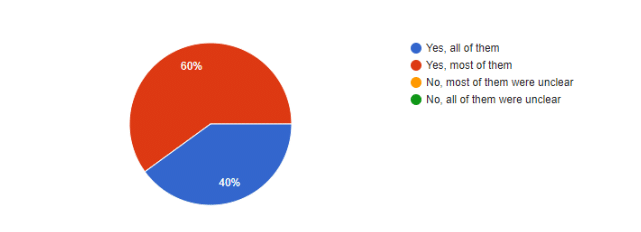A few weeks ago, I sent our monthly report to my leaders, outlining our achievements and challenges. One of the highlights I enthusiastically included was “Our content is improving alongside the improved quality of our briefs.”
I was comfortable with that statement until our CMO asked, “How are we determining this? Which criteria are we using to “measure” quality of content creation?” At that time, I replied:
“We have not been able to measure the quality of our content directly through data yet. However, we analyzed qualitatively some old briefs and old content, compared to new briefs and new content. We have realized that our recent blog posts are answering the search intent of each keyword more effectively than before. […] To ensure the quality of our content, we provide detailed briefs to our writers, which also instruct them regarding the standards we expect them to follow while creating their pieces. We also provide detailed feedback to them and ask for revisions whenever something is not aligned with what was in the brief.”
I wasn’t lying. It was crystal clear that both our briefs and content created from them had seen improvements. But honestly, I wasn’t fully satisfied with my answer.
As an SEO professional, I knew I should back it up with concrete data, as our CMO asked. But where to start from?
High-Quality Briefs for High-Quality Content
First, I should explain to you that we outsource most of our content. And the skilled writers responsible for crafting them are on WriterAccess.
Our content creation platform has over 15,000 professionals from various fields and countries. We use AI-powered tools to find those who best match our needs and send them content briefs with our requirements.
Content briefs – here’s my thesis about them:
A good brief is vital for high-quality content. Briefs serve as the roadmap that directs the creation of every piece of content.
As a content marketing business, we can’t afford to overlook their significance; however, we may have come close to making this mistake. Not for too long, though.
As 2023 began, we reflected on the instructions that would clearly guide our freelance writers to produce pieces that truly resonated with our audience. In that spirit, we revamped our content briefs.

Personally, I felt a great sense of pride in our new brief template and the meticulous approach we adopted while filling them out. But what did the freelance writers think about them? So, this question became the starting point of my research.
I created this form to collect our freelance writer’s valuable insights, and their answers made me realize two main things: 1) our content briefs efforts are paying off; 2) we still have room for improvement, and we will keep doing so.
Are you ready to dive into my findings? I recommend you to stick around because they are really interesting and can assist you in refining your content brief creation process.
Writer’s Valuable Insights on Our Content Briefs
Among the respondents, only one started writing for Rock Content in 2023, while the others have been with us for at least one year. This timeframe allowed them to compare our old briefs with the new, enhanced ones.
To start off, I’d like to share the freelance writers’ opinions on how much the quality of the brief impacts their writing process. Here’s what I found out:

Some of their remarks regarding this topic included:
“The brief bridges what the clients want with what I write. If it’s not clear, it leaves too much up to interpretation by me. When that happens, the client rarely gets the piece they envisioned.”
“A good brief makes writing an article easy and simple. […] A poor brief leaves me more confused and unsure about what needs to be included and what subtitles and headings will make the client happy with the outcome of the blog.”
“I refer back to content briefs constantly as I write and often copy/paste keywords, necessary links, and requested important points into a separate document so that I can cross each one off as I include it. The more direction there is, the easier it is for me to mentally plan the piece and bring it together as I work on it.”
“This is more specific to new clients than to Rock Content. Without a full understanding of the clients’ marketing scope and the stage of the customer journey, having the additional information in the brief is critical for success. In addition, having the tone and voice guidelines available in the brief helps ensure that the content I provide blends seamlessly with their other marketing assets.”
“If the brief isn’t clear, it’s a guessing game to deliver what you want. It’s also less helpful, and takes up a lot of time, when there is so much information that I have to pick through it to find the bits that I actually need.”
As I mentioned before, content briefs are like road maps, and I’m glad the writers recognize it. Now, let’s explore some other questions from the form.
Close-ended questions
One of the most important ones was: “Have you noticed any improvements in the briefs you received during the months of April and May [when the changes were implemented] compared to the ones you received earlier”?
80% of the freelance writers noticed some kind of improvement in the briefs, among them 50% noticed a lot of improvement.
I also asked the respondents about the clarity of our content briefs, using a rating scale from 1 to 5. A rating of 1 meant “not clear at all,” while a rating of 5 meant “very clear.” Interestingly, none of the respondents rated the briefs as 1 or 2, and a majority of 60% gave them a top rating of 5 for clarity.
I was also curious to know if the new briefs provided a thorough understanding of the topic to be covered, 40% voted “all of them” and 60% voted “most of them”.

Then I asked the writers to indicate their level of agreement with the following statement: “There were insights or guidance provided regarding the user intent or needs of the audience.” Here’s their response:

When it comes to how clearly we state our tone and style in the content briefs, 50% agree that they’re clear, and 20% strongly agree with that. On the other hand, 20% are neutral about it and 10% strongly disagree.
When asked about sections in the brief that they consider unnecessary for their work, some data worth mentioning is that 70% considered “Author information” useless, 50% indicated “Visual elements” and 30% don’t see value in our list of “Top-ranking competing content”.
I was particularly interested in the writers’ feedback regarding their satisfaction with the overall quality of our new briefs compared to the old ones. It was important for me to gather their responses and compare the two.
When queried about their satisfaction with the new briefs on a scale of 1 to 5, with 1 being “extremely dissatisfied” and 5 being “extremely satisfied,” 80% of the writers voted 4 or 5. None of them voted 1 or 2. However, the feedback for the old briefs was different. Only 10% voted 5, while 80% voted 3 and 4, and 10% voted 2 (dissatisfied).

Open-ended questions
Additionally, I gathered insights by posing open-ended questions regarding the writers’ preferences and critiques regarding both the new/updated and old briefs. Here are a few excerpts from their feedback:
“[…] I’d say the more recent the briefs, the better/more clearer they’ve been. I wasn’t dissatisfied with the old briefs, but I really like the amount of detail included in the new ones.”
“This content brief provided just enough information on what needed to be included, while still allowing for the writer to use [their] own creativity. Briefs that include too much micro-management in what is to be written are stagnating, at least to this writer, so this one had just the right mix.” (Referring to an updated brief)
“Generally, the less information/direction, the less I liked the brief. I just really like knowing that the client and I are on exactly the same page.”
“I can’t remember individual ones, but I remember not even picking up some articles because the language on the brief just wasn’t clear enough to tell me what was needed.” (Referring to old briefs)
“I have written articles for clients who simply gave me a single word to go on […] and others who provide full outlines. Given my preference, I would say something in the middle is best for me. As a senior-level marketer with 15 years of corporate experience, I intuitively know where to take much of the content so the additional info is often just “noise” for me to scroll through.”
“The only complaint I have is that the briefs are very long. I find myself having to open the page on two tabs – one to reference the brief and another to write the content. If there’s a way to shorten or format the brief so the outline is close to the text box, that would streamline the writing process.” (Referring to updated briefs)
Data Insights: What I Learned From The Writers’ Feedback
I’m sure you have drawn your own conclusions after reading the writers’ feedback shared in the previous section. However, I invite you to explore what I have learned:
1. We have improved, it’s noticeable.
We’re communicating our intentions and goals more effectively than before. The details included in the updated version of our briefs help most freelancers feel guided and more confident about their work.
I understand why more experienced writers in our industry might view detailed information as “noise,” and I empathize with their perspective. However, our approach typically involves crafting briefs tailored for writers with a mid-level of expertise.
We primarily process our orders on a first-come, first-served basis, and while we prioritize our “love list” of writers, they possess varying levels of expertise.
2. We must improve how we communicate our desired tone and style.
30% of respondents being neutral or strongly disagreeing with the statement “The desired tone and style of the content were clearly stated in the briefs” is a point of attention.
Honestly, it just confirmed what we had already noticed and started to work on. We’re currently developing a new style guide to share with our writers.
3. We can remove certain sections from the briefs to make them shorter and more concise.
I agree, they have indeed become a bit lengthy.
Many of the sections that the writers indicated as unnecessary, such as ‘Author information,’ we use only internally, so we can certainly leave them aside.
However, the fact that 30% of them see our list of “Top-ranking competing content” as unnecessary is a bit concerning. We may be failing to clarify the importance of some information we include in our briefs.
Analyzing “top-ranking competing content” before writing an SEO piece is crucial for writers to gain insights into the competition, identify content gaps, and create more effective and targeted content that can rank higher in search results.
You may wonder: “Shouldn’t freelance writers already know this?” SEO knowledge does indeed enhance their work, and I highly recommend investing time in it. However, we can assist them by explaining concepts like the one mentioned above.
4. I confirmed the importance of consistently providing feedback to our writers for every piece of content they create.
Although I haven’t previously mentioned this data, 90% of them find our feedback highly valuable, and we witness its practical impact.
Our writers excel at receiving feedback, and we observe noticeable improvements from one article to the next.
What I’ve learned from the writers’ responses confirms my thesis: A good brief is vital for high-quality content. It provides clear guidelines, objectives, and audience insights, ensuring content creators understand project expectations.
By facilitating effective communication and aligning visions, a comprehensive brief helps develop relevant and engaging content that resonates with the audience, delivering the intended message effectively.
What Google Analytics Tells Us About Our Content Quality
I know I mentioned how a good brief helps in creating more engaging content that deeply connects with our audience, but I haven’t quite proven it yet. Stay with me because we’re about to reach that point.
First, let me remind you that Google Analytics provides valuable insights into our content quality. By analyzing specific metrics, we can gain a more in-depth understanding of how our content resonates with our audience.
Rock’s Content Performance
Here are three key metrics and our results, which I would like to share with you. I’ll compare data from April 1st to May 31st, 2023 (after we started implementing the updated briefs) with the same period last year:
- Bounce Rate: This metric reveals the percentage of visitors who leave a website after viewing just one page.
From April 1st to May 31st, 2023, our bounce rate reduced by 3.94% compared to the same period last year. This improvement indicates that visitors are engaging more with our website and exploring multiple pages before leaving.
- Time on Page: This metric measures the average amount of time visitors spend on a particular page or set of pages.
From April 1st to May 31st, 2023, our average time on page increased by 23.73%. A longer time on page suggests that our recent content is more captivating and holds the attention of our audience.

- Average session duration: Session duration, or average session duration, measures the average time visitors spend on a website during a session.
From April 1st to May 31st, 2023, our average session duration increased by 7.84%. A longer session duration generally suggests that visitors find our content valuable and are spending more time consuming it.
While it is important to acknowledge that each year has its unique characteristics and the data presented here cannot be attributed solely to improvements in content quality, the analysis of these metrics collectively indicates that we are indeed heading in the right direction.
It suggests that well-crafted and high-quality briefs contribute to the creation of content of similar caliber, which in turn leads to increased engagement from our audience.
Final Remarks
At the time our CMO asked how I could affirm that our content quality was improving, I hadn’t yet gathered all this information.
I answered him based on a comparison between articles written in the past with the ones written after our updated briefs were launched. I took into consideration aspects like readability, keyword use, capacity to answer user intent, and source quality.
Now I can tell both qualitatively and quantitatively that our content is improving along with the quality of our briefs.
Am I happier with my current answer? Yes, definitely. However, I also know there’s a lot of room for improvement and more key metrics to analyze in the future.
Would you also like to take one step further toward improving your content creation? Why not give WriterAccess a try today?
Enjoy 14 days of free access to our network of expert writers and discover what great content can do for your business!
Oh, and don’t forget to reference this article when creating your content briefs and connecting with our talented writers. Good luck!
Do you want to continue to be updated with Marketing best practices? I strongly suggest that you subscribe to The Beat, Rock Content’s interactive newsletter. We cover all the trends that matter in the Digital Marketing landscape. See you there!







